Taking on GM’s Big-Cube Engines
By Doc Frohmader, restoration contributor
While some engines are relatively rare in performance and engine machine shops, the big Cadillacs have remained a consistent source of income for these businesses. These engines are Cadillac’s last hurrah at traditional big-cube, flagship GM engines. Surprisingly, they are also a scaled-down version of a V12 engine that made it through early production and road-testing before being scrapped as a result of EPA and CAFE regulations. (Like the old saying goes — timing is everything.)
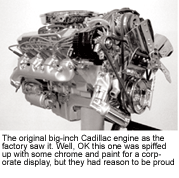 The big-cube powerplant is a relatively low-rpm engine, designed primarily to take advantage of large quantities of torque and run quiet and smooth, which has always been Cadillac’s goal. Today, these engines are being built for restorations, but increasingly more often for distinctly non-stock applications. A source of relatively cheap basic power, they’ve found themselves in drag racing, air-boating and even trucking. There are a lot of performance parts available for them including several stroker kits and even a set of bad boy aluminum heads. Both stock and performance variations of pistons are available. In other words, a sufficiently large enough demand was created to make the aftermarket sit up and take notice. Now it’s up to you to use that information to benefit your business.
The big-cube powerplant is a relatively low-rpm engine, designed primarily to take advantage of large quantities of torque and run quiet and smooth, which has always been Cadillac’s goal. Today, these engines are being built for restorations, but increasingly more often for distinctly non-stock applications. A source of relatively cheap basic power, they’ve found themselves in drag racing, air-boating and even trucking. There are a lot of performance parts available for them including several stroker kits and even a set of bad boy aluminum heads. Both stock and performance variations of pistons are available. In other words, a sufficiently large enough demand was created to make the aftermarket sit up and take notice. Now it’s up to you to use that information to benefit your business.
The problem with all this lies in the fact that it is not a small block Chevrolet. What I mean is that when performance is discussed among the uninformed, all engines tend to be lumped into the same pile. People expect that just because it works on a Chevy, it will automatically work on another, completely different engine series. This is no truer than when it comes to the big Caddys. I can guarantee you that if you build one like a Small Block Chevy (SBC), you will not like the results.
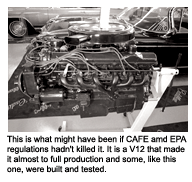 Difference in Design
Difference in Design
One primary reason for this is the basic engineering concepts employed by both. The SBC is designed to be a relatively fast-revving engine, often accommodating a 3,000 rpm-plus cruise and bursts well above 5,000. It relies on horsepower developed through rpm.
The Caddy engines are designed for torque production at lower rpm. A cruise rpm of 1,800-2,200 is common. Spinning them over 4,000 in stock condition is chancy, and while you can modify the Cadillacs to spin faster, it is not cheap and it involves more than just heavier valve springs. So be warned: A smart builder will not be tempted to confuse the Cadillacs with Chevrolets and spec out parts that aren’t appropriate.
So, you ask, what does work when it comes to reusing these engines? The answer is not a pat thing and you will always have variations and applications requiring special modifications. In fact, I see building Cadillacs as falling into categories — restoration, street performance, trucks, boats and race.
For serious racing, it takes a significant amount of modification to make them truly competitive. While this can and has been done, the effort is too complex to cover in this article, so I’ll duck it for now. In fact, for most shops the major interest is going to be for relatively stock engines or engines with modest, streetable modifications. For these applications, a great deal can be said that will give you a leg up on a successful build.
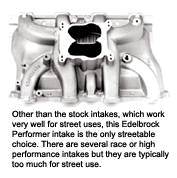 As you would expect, all the required parts to rebuild and restore these engines are readily available. There are a number of internal engine component makers that can supply you with quality parts in almost every variation, so for the stock/restoration build, you can rest easy over parts availability. If you need something exotic, such as custom pistons, even those can be ordered from most suppliers these days.
As you would expect, all the required parts to rebuild and restore these engines are readily available. There are a number of internal engine component makers that can supply you with quality parts in almost every variation, so for the stock/restoration build, you can rest easy over parts availability. If you need something exotic, such as custom pistons, even those can be ordered from most suppliers these days.
Out with the Old…
Like any vintage engine, hindsight allows us a chance to reassess and modify the original production engine. This is certainly true with the big-inch Cadillacs. I recommend several upgrades to any Caddy you are building. Throw away the OEM-style nylon valve seals. Over time they get brittle, fall apart and contaminate the oil supply. I’ve used both modern umbrella seals and positive seals as replacements with excellent results. As a rule, I prefer the positive seals for all the obvious reasons, but you may not always get the customer to OK the extra cost. In conjunction with this, I have had great success using bronze valve guide liners instead of any iron replacement.
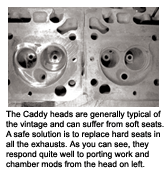 Throw the original type nylon-coated timing set as far as you can. These things should only be used in classrooms as examples of a very bad engineering exercise gone horribly wrong. While they work fine for a while, you will rarely see an engine equipped with them free of a crankcase full of nylon debris. They don’t last, and as they die, they foul the oil system. If you find them, don’t use them. (Note: Melling has a fine set with a cast iron cam gear and a heat-treated sintered iron crank gear along with a standard link chain.) Plus, there are aftermarket roller chains available, so check out your favorite supplier catalog.
Throw the original type nylon-coated timing set as far as you can. These things should only be used in classrooms as examples of a very bad engineering exercise gone horribly wrong. While they work fine for a while, you will rarely see an engine equipped with them free of a crankcase full of nylon debris. They don’t last, and as they die, they foul the oil system. If you find them, don’t use them. (Note: Melling has a fine set with a cast iron cam gear and a heat-treated sintered iron crank gear along with a standard link chain.) Plus, there are aftermarket roller chains available, so check out your favorite supplier catalog.
The stock or stock replacement valves are fine and there really are no major issues except for sunken seats. Obviously, damaged seats need repair and the root cause corrected. But these heads suffer from a problem rampant in similar vintage production. The way I see it is that when the no-lead fuels were introduced, it quickly became evident that hardened seats were going to be a requirement. Rather than going with inserts, the OEMs began induction-hardening the seat areas. Early on, it was found that if the seats were hardened to too great a depth they would crack. The fix was to strive for a depth of something like 0.050” to the hardened material.
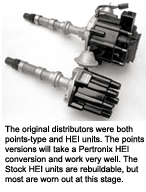 Unfortunately, this type of hardening is not so infinitely controllable as to make it perfectly uniform. The practical result was quite interesting. First, the vast majority of the original engines never had a problem with sunken seats. The original hardening was quite enough to protect them. Most problems arose when the seats were ground. Spots or areas where the hardening was thin were machined away or reduced to the point where the seats became soft and would not last. I’ve seen where an entire set sucked right up in just a couple thousand miles.
Unfortunately, this type of hardening is not so infinitely controllable as to make it perfectly uniform. The practical result was quite interesting. First, the vast majority of the original engines never had a problem with sunken seats. The original hardening was quite enough to protect them. Most problems arose when the seats were ground. Spots or areas where the hardening was thin were machined away or reduced to the point where the seats became soft and would not last. I’ve seen where an entire set sucked right up in just a couple thousand miles.
The safe solution from my perspective is to simply install hard seats in all the exhausts. Yes, it will add to the cost, but since the problem is documented, why take chances? You can be assured that most engines of this vintage share the same kind of issue.
Off Your Rocker
Rocker arms are also a sore spot for these engines. These days, according to a Caddy-fluent remanufacturer I know, it takes up to eight or 10 full sets to get 16 useable OEM rockers! For all practical purposes this puts them in the category of “unobtainium.” The solution is to go with an aftermarket shaft-style setup, all of which seem to be built by Rocker Arm Specialist. Last I checked, the basic version using a stamped Buick rocker cost something like $250 a set, so while it’s an additional cost, it is not outrageous or a deal killer. A stronger set using Ford rockers and roller billet aluminum sets also are available if you need them. A real advantage to this is that the engine will be able to better handle higher rpm than before.
The thing is, just the rockers won’t make the Cadillac a high-rev engine. Cadillac designed what it needed for the cars it produced and with gear ratios of either 2.41 or 2.71:1 and 78-series tires they ran low rpm. About the time you drop a 500 in a pickup with 3.73 gears, you create a lot of complications. You can run a set of stock valve springs if you want, but they have very light seat pressure (60 lbs.) and light open pressure. So, for extended use over 3,000 rpm, I recommend you’ll need an upgrade.
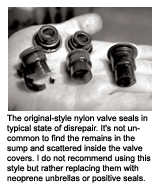 And, as a rule, don’t re-use springs. Equally important is to not go overboard. Stock Cadillac lifters will not support a heavy spring, can be noisy and often collapse overnight if used. There are replacement lifters from Chevrolet applications that work fine. Make sure you check the lifter preload when you make any of these changes.
And, as a rule, don’t re-use springs. Equally important is to not go overboard. Stock Cadillac lifters will not support a heavy spring, can be noisy and often collapse overnight if used. There are replacement lifters from Chevrolet applications that work fine. Make sure you check the lifter preload when you make any of these changes.
When building for a non-stock application, make sure you also have supporting ignition and carburetion. The GM High Energy Ignition (HEI) units are notorious for wearing out. They can be rebuilt and aftermarket units including billet HP units are available. A bad one or one with an incorrect advance curve will drive you crazy and make your customer pull out his hair. The only place a stock unit with a stock advance curve seems to work is in restoration engines. In my experience, all others will require changes.
Fuel Delivery
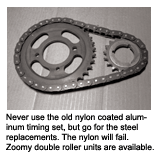 Carburetors are no less tricky than some of the other components we’ve discussed. The Q-Jets used on the Caddy engines are fine and operate well until those rpm range changes are included. The best current theory as to why a Caddy will perform perfectly in a stock setup but fail miserably in a truck has to do with calibration. These carbs were designed for use with heavy smog control and were lean from the factory to accommodate the EPA requirements. Change the operating rpm range and vehicle characteristics and suddenly you have a carb that won’t work. So far I’ve found that increasing jets from two to four sizes is a good start, but that you’ll have to play with each one to get it right. Meanwhile, building an engine that will be using an incorrectly calibrated carb could be a nightmare of overheating, burned valves and fried pistons. Make sure you communicate clearly with your customer to protect yourself from this. And get it in writing so you won’t assume responsibility for wrecking a perfectly good engine with a bad installation.
Carburetors are no less tricky than some of the other components we’ve discussed. The Q-Jets used on the Caddy engines are fine and operate well until those rpm range changes are included. The best current theory as to why a Caddy will perform perfectly in a stock setup but fail miserably in a truck has to do with calibration. These carbs were designed for use with heavy smog control and were lean from the factory to accommodate the EPA requirements. Change the operating rpm range and vehicle characteristics and suddenly you have a carb that won’t work. So far I’ve found that increasing jets from two to four sizes is a good start, but that you’ll have to play with each one to get it right. Meanwhile, building an engine that will be using an incorrectly calibrated carb could be a nightmare of overheating, burned valves and fried pistons. Make sure you communicate clearly with your customer to protect yourself from this. And get it in writing so you won’t assume responsibility for wrecking a perfectly good engine with a bad installation.
Taking a Lot of Heat
Speaking of heat, one issue you need to recognize is that these engines will almost never run at 180°. I have never seen one to run at less than 210° and often see them running fine at 220° or 230°. These engines employ thin-wall, hard alloy block castings and they transfer heat more rapidly than softer cast, thicker-walled blocks. While I certainly support oil coolers, high-capacity fans and large radiators to mitigate heat issues, don’t chase your tail trying to do what for all practical purposes can’t be done and serves no essential purpose.
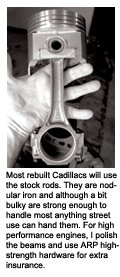 However, because of this you will find that Cadillacs can be detonation sensitive. Again, for all practical purposes, this creates limits. While it is possible to go higher, I’ve found that when you get over about 8.5:1 compression you are playing at the limits of compression for street uses. Cooling the engine down, adding a cold air intake, altering the cam profile and even the aftermarket aluminum heads are part of a high-compression regimen.
However, because of this you will find that Cadillacs can be detonation sensitive. Again, for all practical purposes, this creates limits. While it is possible to go higher, I’ve found that when you get over about 8.5:1 compression you are playing at the limits of compression for street uses. Cooling the engine down, adding a cold air intake, altering the cam profile and even the aftermarket aluminum heads are part of a high-compression regimen.
Intake manifolds are interesting. For street use, you really only have the stock items or the Edelbrock Performer. As ugly and squat as the stock intakes are, they are also the best choice for many street uses. The Performer works well, but it is a better choice when running at higher rpm. It will raise the horsepower and torque ranges, but have little effect on peak numbers. Obviously this changes when higher-end performance modifications are factored in.
Cams are no less an issue. It seems as if everyone has their own version of what works best. To tell the truth, I suspect that too often cams are sold on a basis of what was available or what worked on some other engine rather than being tailored for your specific needs. I’ve found that for trucks, stockers and milder street versions, a very conservative cam seems to work well. My favorite truck cam runs 218° at 0.050”, for example. Interestingly, going for a longer duration cam will allow you to run more compression and reap more power, but it costs in fuel mileage considerably. You will probably want to design the engine to suit the needs of the customer in terms of rpm range, vehicle, and expectations for performance and economy.
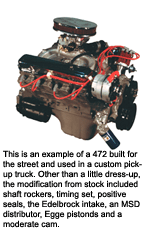 Finally, most of these engines will use the stock crank, rods and stock-style pistons. The cranks are cast and have no history of failures even when used in harsh or high-performance applications. Rods are cast nodular and are bulky but also do a yeoman’s job. Pistons were once hard to find, but as stated, some suppliers offer a full selection of cast stock replacements and hypereutectic performance pistons for those who want to step it up. Other piston suppliers have shorter lines of replacement product for specific engines.
Finally, most of these engines will use the stock crank, rods and stock-style pistons. The cranks are cast and have no history of failures even when used in harsh or high-performance applications. Rods are cast nodular and are bulky but also do a yeoman’s job. Pistons were once hard to find, but as stated, some suppliers offer a full selection of cast stock replacements and hypereutectic performance pistons for those who want to step it up. Other piston suppliers have shorter lines of replacement product for specific engines.
In summation, Cadillacs (like most vintage engines) have their own unique characteristics and design. The vast majority of common uses are best served by considering these and incorporating them into a successful build, rather than trying to recreate or re-shape the engine to do what it was not designed for. For example, you wouldn’t want to try to convert a Chevy V6 into a diesel for a school bus, even though it is theoretically possible because of practical and economic limits. In the case of the big-inch Cadillacs, building practical and economical variations generally means working with the cubic inches and stock head designs to produce a low to medium rpm engine with gobs of torque.
Editor’s Note: Although there are a few automotive parts suppliers and service providers mentioned in this article, Underhood Service does not endorse these products as the only ones to use. There are a number of aftermarket companies that manufacture or rebuild similar components, and it is up to the reader to make educated choices when contracting out for these Cadillac engine parts.


